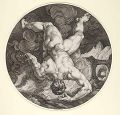Tantalus

Tantalus (Greek Τάνταλος) was the ruler of an ancient western Anatolian city called either under his name, as "Tantalis",[1] "the city of Tantalus", or as "Sipylus", in reference to Mount Sipylus at the foot of which his city was located and whose ruins were reported to be still visible in the beginning of the Common Era,[2] although few traces remain today. Pausanias further reports that there was a port under his name and a sepulchre of him "by no means obscure", in the same region. In Greek mythology he was the father of Pelops, Niobe and Broteas, and a son of Zeus[3] and the nymph Plouto.
Tantalus is referred to as "Phrygian" and sometimes even as "King of Phrygia",[4] although his city was located in the western extremity of Anatolia where Lydia was to emerge as a state before the beginning of the first millennium BC, and not in the traditional heartland of Phrygia, situated more inland. References to his son as "Pelops the Lydian" led some scholars to the conclusion that there would be good grounds for believing that he belonged to a primordial house of Lydia.
Other versions name his father as Tmolus, the name of a king of Lydia and, like Sipylus, of another mountain in ancient Lydia. The location of Tantalus' mortal mountain-fathers generally placed him in Lydia; [5] and more seldom in Phrygia[6] or Paphlagonia,[7] all in Asia Minor.
The identity of his wife is variously given: generally as Dione, but whose name may simply mean "The Goddess," or perhaps as the Pleiad with that name; or as Eurythemista, a daughter of the river-god Xanthus; or Euryanassa, daughter of Pactolus, another river-god, both of them in Anatolia; or Clytia, the child of Amphidamantes (Graves 1960, section 108). Tantalus, through Pelops, was the founder of the House of Atreus.
The geographer Strabo, quoting earlier sources, states that the wealth of Tantalus was derived from the mines of Phrygia and Mount Sipylus. Near Mount Sipylus archaeological features that have been associated with Tantalus and his house since Antiquity. Near Mount Yamanlar in İzmir (ancient Smyrna), where the Lake Karagöl (Lake Tantalus) associated with the accounts surrounding him is found, is a monument mentioned by Pausanias: the tholos "tomb of Tantalus" (later Christianized as "Saint Charalambos' tomb") and another one in Mount Sipylus,[8] and where a "throne of Pelops", an altar or bench carved in rock and conjecturally associated with his son is found. A more famous momument, a full-faced statue carved in rock mentioned by Pausanias is a statue of Cybele, said to have been carved by Broteas by Pausianias is in fact Hittite.
Further afield, based on a similarity between the names Tantalus and Hantili, it has been suggested that the name Tantalus may have derived from that of these two Hittite kings.[9]
In Robert Graves' historical novel, Hercules, My Shipmate, Graves appears to claim that Tantalus was a member of an invading Greek tribe who was condemned to his torment in Tartarus for refusing to reject his patriarchal deities in favor of a local version of Ashtoreth.
Thus, like other heroes in Greek mythology such as Theseus, or the Dioskouroi, Tantalus had both a hidden, divine sire and a mortal one.
Contents |
Story of Tantalus
| Greek underworld | |
|---|---|
| Residents | |
|
|
| Geography | |
|
|
| Famous inmates | |
|
|
| Visitors | |
In mythology, Tantalus became one of the inhabitants of Tartarus, the deepest portion of the Underworld, reserved for the punishment of evildoers; there Odysseus saw him.[10] The association of Tantalus with the underworld is underscored by the names of his mother Plouto ("riches", as in gold and other mineral wealth), and grandmother, Chthonia ("earth").
Tantalus was initially known for having been welcomed to Zeus' table in Olympus, like Ixion. There he is said to have misbehaved and stolen ambrosia and nectar to bring it back to his people,[11] and revealed the secrets of the gods.[12]
Most famously, Tantalus offered up his son, Pelops, as a sacrifice to the gods. He cut Pelops up, boiled him, and served him up as food for the gods. The gods were said to be aware of his plan for their feast, so they didn't touch the offering; only Demeter, distraught by the loss of her daughter, Persephone, did not realize what it was and ate part of the boy's shoulder. Clotho, one of the three Fates, ordered by Zeus, brought the boy to life again (she collected the parts of the body and boiled them in a sacred cauldron), rebuilding his shoulder with one wrought of ivory made by Hephaestus and presented by Demeter. The revived Pelops was kidnapped by Poseidon and taken to Olympus. Later, Zeus threw Pelops out of Olympus due to his anger at Tantalus. The Greeks of classical times claimed to be horrified by Tantalus's doings; cannibalism, human sacrifice and infanticide were atrocities and taboo.
Tantalus's punishment for his act, now a proverbial term for temptation without satisfaction (the source of the English word "tantalise" - US "tantalize"),[13]) was to stand in a pool of water beneath a fruit tree with low branches. Whenever he reached for the fruit, the branches raised his intended meal from his grasp. Whenever he bent down to get a drink, the water receded before he could get any. Over his head towers a threatening stone, like that of Sisyphus.[14]
In a different story, Tantalus was blamed for indirectly having stolen the dog made of gold created by Hephaestus (god of metals and smithing) for Rhea to watch over infant Zeus. Tantalus's friend Pandareus stole the dog and gave it to Tantalus for safekeeping. When asked later by Pandareus to return the dog, Tantalus denied that he had the dog, saying he "had neither seen nor heard of a golden dog." According to Robert Graves, this incident is why an enormous stone hangs over Tantalus's head. Others state that it was Tantalus who stole the dog, and gave it to Pandareus for safekeeping.
But Tantalus was also the founder of the cursed House of Atreus in which variations on these atrocities continued. Misfortunes also occurred as a result of these acts, making the house the subject of many Greek Tragedies. Tantalus's grave-sanctuary stood on Sipylus[15] but honours were paid him at Argos, where local tradition claimed to possess his bones.[16] In Lesbos, there was another hero-shrine in the small settlement of Polion and a mountain named after Tantalos.[17]
Interpretations of the Tantalus figure
The tale of Tantalus reaffirms that human sacrifice and infanticide are taboo in Ancient and Classical Greek culture. Yet it seems to suggest that human sacrifice had once been offered in archaic times, especially to Demeter. Alternatively, Tantalus can be seen as a Promethean figure who divulges divine secrets to mortals. He presides over sacred initiations consisting of mystic death and transfiguration. His dismemberment of Pelops and Pelops' resurrection can be seen as an archetypal shamanic initiation.
Other characters with the same name
There are two other characters named Tantalus in Greek mythology, both minor figures and both descendants of the above Tantalus. Broteas is said to have had a son named Tantalus, who ruled over the city of Pisa in the Peloponnesus. This Tantalus was the first husband of Clytemnestra. He was slain by Agamemnon, King of Mycenae, who made Clytemnestra his wife. The third Tantalus was a son of Thyestes, who was murdered by his uncle Atreus, and fed to his unsuspecting father.
Related terms
The name "Tantalus" is the origin of the English verb "to tantalize". The underlying idea is that when someone is tantalized, that person goes through the same experience as Tantalus: something desirable is always just out of that person's reach.[18]
A Tantalus, by an obvious analogy, is also the term for a type of drinks decanter stand in which the bottle stoppers are firmly clamped down by a locked metal bar, as a means of preventing servants from stealing the master's liquor. The decanters themselves, however, remain clearly visible.
The chemical element tantalum (symbol Ta, atomic number 73) is named after the mythological Tantalus; its lack of reactivity, and the resulting difficulty in isolating the pure metal from ore, gave the element its name, by analogy; the pure metal tantalized chemists.
In naval history, an early 20th century British Merchant Navy freight ship (SS Tantalus) and a United States Navy landing craft repair ship of the World War II (USS Tantalus (ARL-27)) were named after Tantalus.
In serial television fiction, the episode "Mirror, Mirror" of Star Trek: The Original Series, a mirror universe device that allows users to monitor, transport to or eliminate a person from a location within its range was termed a "Tantalus device".
In the 2007 game Mass Effect, the engine of the main character's ship is called the Tantalus Drive Core, due to its abilities and the amount of research that went into its creation.
Tantalus in art
 1588 engraving by Hendrik Goltzius and C. Cornelius |
 Oil painting by Gioacchino Assereto (circa 1640s) |
 1797 etching by Francisco Goya |
See also
- Pelops
- Niobe
- Broteas
- Mount Yamanlar
- Mount Sipylus
- House of Atreus
Notes
- ↑ George Perrot (2007) (in French, English). History Of Art In Phrygia, Lydia, Caria And Lycia p. 62 ISBN 978-1406708837. Marton Press.
- ↑ James George Frazer (1900-1913-1965). Pausanias, and other Greek sketches, later retitled Pausanias's Description of Greece ISBN 1428649220, ISBN 978-1428649224. Kessinger Publishing Company.
- ↑ Euripides, Orestes.
- ↑ Thomas Bulfinch. Bulfinch's Mythology ISBN 1419111094, 1855 - 2004. Kessinger Publishing Company.
- ↑ Pindar Olympian Ode 1.24-38, 9.9; Strabo 1.3.17; Pausanias 5.1.6, 9.5.7.
- ↑ Strabo, xii.8.21
- ↑ Diodorus Siculus, 4.74.
- ↑ Various sites called the "tomb of Tantalus" have been shown to travellers since the time of Pausanias.
- ↑ M. L. West (1999) (in English). The East Face of Helicon: West Asiatic Elements in Greek Poetry and Myth p. 475 ISBN 978-0198152217. Oxford University Press.
- ↑ Odyssey xi.582-92; Tantalus' transgressions are not mentioned; they must already have been well-known to Homer's late 8th century hearers.
- ↑ Pindar, TFirst Olympian Ode.
- ↑ Euripides, Orestes, 10.
- ↑ Dictionary.com - tantalize
- ↑ This detail was added to the myth by the painter Polygnotus, according to Pausanias (10.31.12), noted in Kerenyi 1959:61.
- ↑ Pausanias, 2.22.3.
- ↑ Pausanias, 2.22.2.
- ↑ Stephen of Byzantium, noted by Kerenyi 1959:57, note 218.
- ↑ Acme's Cup of Tantalus
References
- Apollodorus, Bibliotheke III, v, 6
- Apollodorus, Epitome II,1-3
- Encyclopaedia Britannica 1911: "Tantalus"
- Gantz, Timothy (1993). Early Greek Myth. Baltimore: Johns Hopkins University Press.
- Graves, Robert (1960, 1962). The Greek Myths.
- Grimal, Pierre, The Dictionary of Classical Mythology, Wiley-Blackwell, 1996, ISBN 9780631201021. "Tantalus" p. 431
- Hyginus, Fabulae 82
- Kerenyi, Karl (1959). The Heroes of the Greeks. New York/London: Thames and Hudson.pp 57–61 et passim
- Ovid, Metamorphoses IV, 458-9; VI, 172- 76 & 403-11.
- Smith, William; Dictionary of Greek and Roman Biography and Mythology, London (1873). "Ta'ntalus"